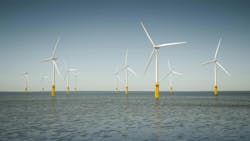DOE and BOEM Release Action Plan to Address Coastal and Offshore Wind Transmission Challenges on the U.S. West Coast
The U.S. Department of Energy’s (DOE) Grid Deployment Office (GDO), in partnership with the U.S. Department of the Interior’s (DOI) Bureau of Ocean Energy Management (BOEM), has released the Action Plan for Offshore Wind Transmission Development in the U.S. West Coast Region (Action Plan) to address coastal and offshore wind (OSW) transmission challenges on the U.S. West Coast.
The action plan provides recommendations on connecting the first generation of West Coast offshore wind projects to the Western electric grid and support transmission over the next several decades, while also producing cost savings, improved grid reliability, local energy resilience, and substantial job creation. To work on the plan, current and anticipated transmission challenges affecting delivery of power to the grid should be addressed.
With the deepwater topography of the ocean off the West Coast, OSW development will require floating technology, which is not yet deployed at scale in the U.S. The West Coast will have an opportunity to demonstrate U.S. leadership in floating OSW technology development and promote domestic energy production, maximize economic benefits and domestic job creation, and enhance the region’s energy grid.
With funding from the Inflation Reduction Act, the Action Plan aims to capture reliable power from wind resources to deliver to communities efficiently. Most of the recommendations are designed for implementation by state governments, Federal agencies, and private developers, but will also benefit Tribes, transmission planners, non-profit organizations, and labor organizations, among others.
The plan’s 50+ recommendations are organized within five categories to address a specific transmission development need.
High-level recommendations include:
- Planning and Operations: A long-term plan using a phased and flexible approach for transmission development will achieve the greatest economic benefit while making the best use of early transmission investments.
- Partnerships, Collaboration, and Community Benefits: Multi-state collaboration, innovative revenue sharing models, and improved inter-agency coordination will be crucial to achieving the effective deployment of coastal and OSW transmission and addressing the needs of local communities.
- Tribal Opportunities & Support: Ensuring that decisions related to coastal and OSW transmission respect Tribal sovereignty and rights and honor the United States’ trust responsibility is a federal priority for coastal and OSW transmission development.
- Technology Advancement and Standardization: Coordinated efforts by government and industry should focus on technology standardization to support a domestic supply chain and incorporate geographic considerations into design specifications.
- Environmental Review, Siting, and Permitting: The responsible development of transmission infrastructure requires a strong foundation of environmental research and development that informs the siting of offshore transmission corridors; minimizes impacts during project planning, construction, operation, and decommissioning; and establishes effective long-term monitoring.
DOE and BOEM performed a series of 12 workshops and released a Request for Information to engage Tribal Nations, federal and state agencies, cable and transmission providers, fisheries organizations, non-governmental organizations, developers, unions, utilities, and other ocean co-users and interested parties to discuss the challenges of coastal and OSW transmission planning along the West Coast.
GDO and DOE’s Wind Energy Technologies Office (WETO) worked with the Pacific Northwest National Laboratory and the National Renewable Energy Laboratory to conduct a transmission analysis along the West Coast from California to Washington.
The study evaluated multiple pathways for OSW through coordinated regional and interregional transmission solutions in the near term (2035) and long term (2040/2045/2050), under various combinations of electricity supply and demand, while supporting grid reliability and resilience and ocean co-use. The West Coast Offshore Wind Transmission Study was published in January 2025.
